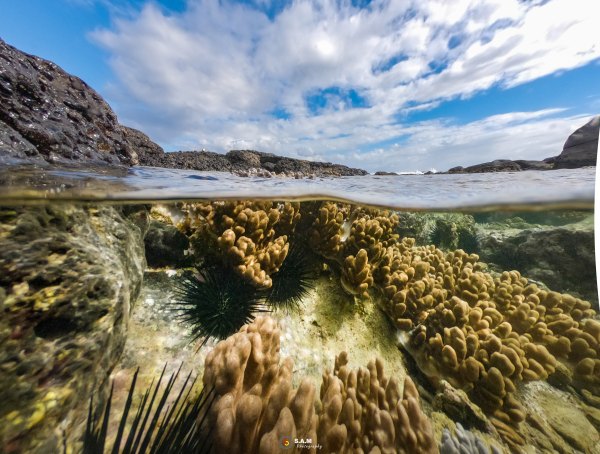The Coral reefs of Mauritius & Rodrigues
Read moreCoral is an invertebrate animal of warm seas. Some corals are solitary but most live in colonies of thousands of individuals. Corals have a skeleton made of calcium carbonate forming a cage around them in which the polyps are located.
The calcium skeleton remains after the death of the animals and on it another generation of animals can develop. The accumulation of the layers of skeletons of the old madrepores with red algae and shells of all kinds build up the corals.
We can therefore say that our corals were the builders of the reefs.
On the surface of the reef, the animal, called polyp, can feed and multiply. There is a peduncle topped by a small organ in the form of a disc with at the end, a slit surrounded by tentacles that are both mouth and anus. It is through these tentacles that the animal captures the plankton and brings it to the mouth.
Coral reefs represent the composition of warm shallow seas. Corals could not exist without the presence of algae. The algae provide carbon molecules to the coral, and in return, the coral food can provide nitrogen and phosphorus to the algae.
Coral is an animal of the Cnidaria (jellyfish) phylum
Polyps are colonies of Corals. Each polyp secretes its own exoskeleton; depending on the species, this exoskeleton is hard (based on calcium carbonate), or soft. The hard corals, "reef builders", have formed by accumulation of these hard skeletons coral reefs). A coral reef is a natural structure whose corals are at the origin.
The largest of these formations, the Great Barrier Reef, off the coast of Australia, extends over some 2,000 km1
In Mauritius, the northern region offers corals of all colors.
In the west, the underwater landscape of Flic-en-Flac has been meticulously cut by the currents. There are canyons, chimneys and caves. Further down the Black River, the corals are much more colorful than on the east coast and are often visited by dolphins.
In the east, there is an extraordinary concentration of marine species. Of all the passes, Belle Mare is the most beautiful. On this coast, the underwater life is more varied because of a greater circulation of water in the lagoon.
The site of Pointe aux Biches (5-12m) includes a small reef fragment with soft and hard corals, surrounded by a large variety of tropical fish.
Holts Rock - Huge rocks of volcanic origin, some of them large, dominate the site. The rocks are riddled with tunnels, caves, crevices and cracks filled with fish and lobsters. In this reef there are also soft corals in fans,
Coral bleaching is a phenomenon of coral dieback, which results in a discoloration of the animal and the reef, due to the loss of pigmentation of the algae. This phenomenon which seems to be steadily increasing in our region can lead to the death of the coral on large areas.
Mauritius, which has more than 160 of the 800 coral species identified worldwide, has lost more than half of its heritage through bleaching, caused mainly by global warming and pollution.
Coral reefs can be found all over the world, from the tropics to the North Sea and the Mediterranean, in the warm seas of Asia and in the cold seas of Great Britain.
More than 800 species of corals exist around the world. And Mauritius has one of the largest Venus brain corals in the Southern Hemisphere, (about 7 meters in diameter!) at the Blue Bay Marine Park.
Of the corals recorded in the world, nearly 200 are located in the lagoon of Mauritius.
The Trou-aux-Biches coral reef regeneration project covers nearly 600,000 m2, with the reintroduction of some 5,000 coral fragments by the end of 2014, on rows of ropes.
Nearly 500 million people depend on coral reefs for the food they provide, the protection they offer, and the. About 30 million of the world's poorest people are totally dependent on coral reefs for food.
Scientists predict massive reef loss in the coming decades as a result of increased CO2 in the atmosphere and global warming. The direct impact of cyclones on coral reefs consists of mechanical destruction due to the strong swell.
With global warming, tropical cyclones are becoming more destructive to coral reefs.
A harmful predator - Proliferation of Acanthaster planci
The Acanthaster planci is a large sea star that feeds on coral tissue.



















